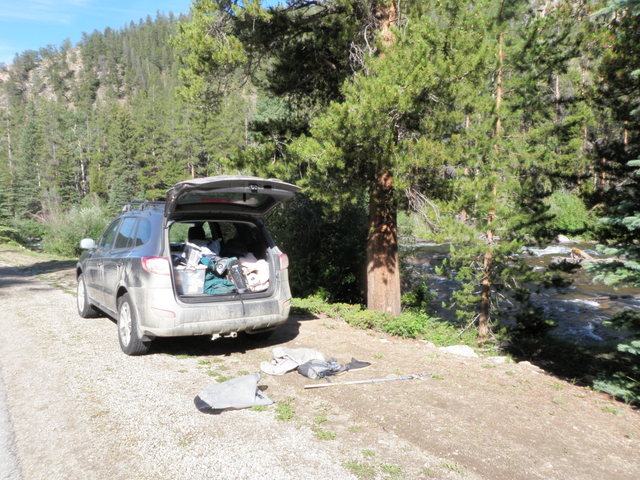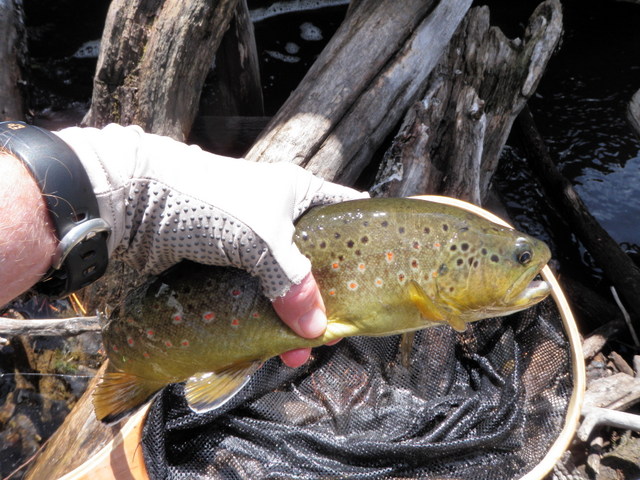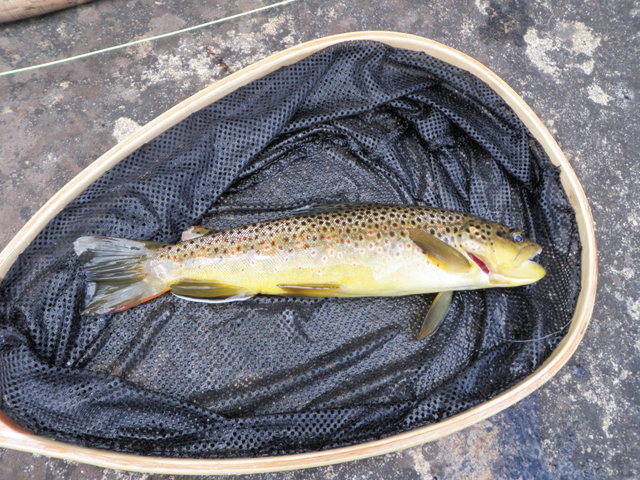Time: 9:30AM – 5:00PM
Location: Same as Thursday but opposite side of river and across from Lodgepole Campground
Fish Landed: 9
Taylor River 08/02/2013 Photo Album
Additional rain fell on my tent Thursday night and I awoke to damp conditions on Friday morning, however, this didn’t stop me from preparing for a day of fishing on the Taylor River. I had some breakfast and then packed a lunch and added a few additional green drakes and light gray comparaduns to my frontpack fly patch. Before the trip I’d cleaned up my patch by removing all the nymphs and wet flies except for one working fly. I placed all the extras in my fleece pouch and this freed up space in the foam patch for additional dry flies.
I made the short drive from the campground to the same parking space as I’d used on Thursday, but my strategy for Friday was to wade across the river at a wide shallow spot just upstream from the car, and then negotiate my way downstream through the woods to a position across from the Lodgepole Campground. In theory the fish on the far side of the river had not been pounded with as many flies as those along the road, and I would be the beneficiary of these less pressured fish. I’d experienced decent success with this approach in previous seasons, and being right handed, I liked working upstream on the left side as it is easier to hook casts in toward the bank and under overhanging vegetation.
The sky was bright blue and largely devoid of clouds and this would continue for most of the day. There was a brief period in the early afternoon where some large clouds temporarily blocked the sun, but these periods didn’t last more than a few minutes. During visits in 2012 I had decent success with a gray parachute hopper trailing a beadhead hares ear, so this became my initial combination on Friday. Despite all the planning and thought just described, I fished for at least 1.5 hours before I experienced any action.
Finally I approached a spot where a large boulder protruded into the river from the bank and a huge pile of branches and sticks created a partial dam between the bank and the large boulder. By this time I’d given up on the hopper/dropper and tied on the same green drake parachute that produced a couple fish for me on Thursday. I carefully climbed to a comfortable position on top of the debris but maintained a low profile and began to prospect the slow area beginning along the left side and gradually fanning out casts to the right. After I’d covered the water left to right I allowed the drake to drift very deep into the nook right in front of the boulder. In another second the fly would be devoured by the swirling current against the rock, but before that scenario could unfold, a fish darted to the surface and sucked in the parachute.
My reflexes kicked in and I set the hook and lifted the rod high to keep the fish out of the debris pile I was standing on. Several times the brown attempted to wrap the line around the sticks, but I kept it upstream. Unfortunately I was not in a good position to net this fighter so I began to carefully step closer on some stable sticks while extending my arm outward and as high as I could. As I did this risky maneuver, the fish finally executed its escape move and darted under one of the branches. Fortunately for me, however, the fish just hunkered there under a few sticks. I made another step to the point where I could reach my net under the stick and scoop the 14 inch brown. Somehow I was able to outwit this underwater foe, so I snapped a few photos and then released the fish. At this point I fed the fly under the branch and extracted it still tied to my line.
After this initial success I continued with the green drake, but the other fish were not as enamored as the 14 incher. Eventually I came to a nice deep run and converted to deep nymphing with a beadhead pheasant tail on the point and this produced a second brown trout. But alas this approach could not repeat the success so I returned to a parachute hopper with a beadhead pheasant tail as the dropper. The pheasant tail probably produced the best particularly during the short period where some clouds blocked the sun, but even this success required much wading and casting.
By 4:30 I’d managed to land 9 trout with the initial brown representing the largest catch of the day. The sunshine and blue skies were ideal for human beings, but apparently not to the liking of brown and rainbow trout in the Taylor River. I crossed the river upstream of the point where I’d crossed in the morning and walked back along the road to a point above the Santa Fe where I’d ended the previous day. I paused and stared at the water in a nice moderate run with around four feet of depth and noticed a nice brown facing the current. This was approximately ten feet above the shallow riffle where I’d landed two rainbows on Thursday evening. I decided to focus on this fish as I could see it was moving side to side and feeding on something.
First I floated a light gray caddis over the brown and it wiggled its tail, but showed no additional signs of feeding. Next I tried a light gray comparadun, and this provoked the trout to move upward three times, but in each case it returned to its holding position after getting no closer than six inches. A small size 18 comparadun with a light yellow body was totally ignored. Next I spotted a size 14 comparadun with a medium olive body, probably a version I tied to imitate the cornuta hatch in Pennsylvania. This fly brought out the worst in my targeted foe as it rose and put its nose against the olive imitation three times, but never opened its mouth to eat. With this indignity now on my record, I glanced at my watch and reailized it was approaching 5PM, so I called it quits and gave the win to the ultra selective trout in front of me.



